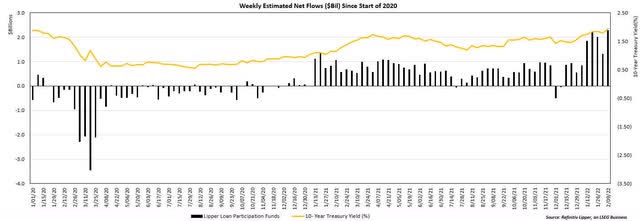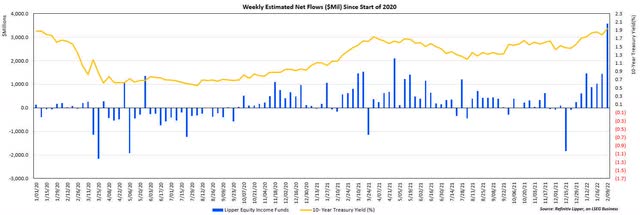[ad_1]
KanawatTH/iStock via Getty Images Refinitiv Lipper

The big news from Thursday, February 10, was the Bureau of Labor Statistics report showing the January Consumer Price Index (CPI) increased more than expected for both month-over-month and trailing 12-month periods.
The CPI jumped 0.6% from December and an astounding 7.5% from last January – marking the largest annual spike in 40 years. Core CPI (excluding food and energy prices) rose by 6.0% over the last year – the largest increase since 1982.
Markets reacted sourly to the news. The NASDAQ (-2.10%), S&P 500 (-1.81%), and DJIA (-1.47%) all fell on the day, while the VIX (+19.79%) and 10-year Treasury yield (+5.29%) jumped.
The two-year Treasury yield increased by its largest amount since 2009. Even though yields are still low based on historical standards, the tone of the Federal Reserve continues to become increasingly hawkish.
St. Louis Fed Chair James Bullard, who is a Federal Open Markets Committee (FOMC) voter, has upped the ante. He has stated his support for a half-point interest rate hike for the next meeting in March – 2000 was the last time an increase of that magnitude occurred.
Refinitiv Lipper
Two Lipper classifications that are currently seeing record inflows in this environment are Lipper Equity Income (EIEI) funds and Lipper Loan Participation (LP) funds.
We’ve talked about the ladder quite a bit, but it is worth mentioning that Lipper Loan Participation funds attracted an all-time weekly record over the last Lipper fund-flows week, pulling in $2.3 billion.
Three of the top weekly inflows on record have poured into this classification over the last four weeks leading to a new monthly record intake in January (+$10.4 billion).
Refinitiv Lipper
The other Lipper classification to report a record-setting week was Lipper Equity Income funds. This classification invests in funds that seek relatively high current income and growth of income by investing at least 65% of their portfolio in dividend-paying equity securities.
Over the past week, EIEI funds realized $3.6 billion in inflows, shattering the previous record by more than $1 billion. This classification is coming off their fourth-largest monthly inflow total to date.
Three huge components to the current attractiveness of this classification are the allocation to the financial sector, insurance sector, and income-producing securities.
For the most part, banks borrow money at a rate from the short end of the yield curve while lending money to borrowers at a rate from the long end of the yield curve.
This spread or net interest margin will increase help to increase earnings. Insurance companies are a second beneficiary from increasing long-term interest rates.
These companies collect premiums from their clients which are then invested by the insurance company. As rates increase, this “float” is invested in higher-yielding bonds which provide a higher rate of return and ultimately boost the earnings for the insurance company.
Lastly, fixed income investors who seek a stable income stream will tend to flock to dividend-paying stocks as an alternative since their yields are being eaten away by rising rates.
The largest attributor this past week to the massive inflows for EIEI was Schwab US Dividend Equity ETF (SCHD, +$1.8 billion). As of December 31, 2021, this ETF’s largest sector allocation was financials (21.69%).
Original Post
Editor’s Note: The summary bullets for this article were chosen by Seeking Alpha editors.
[ad_2]
Source links Google News

